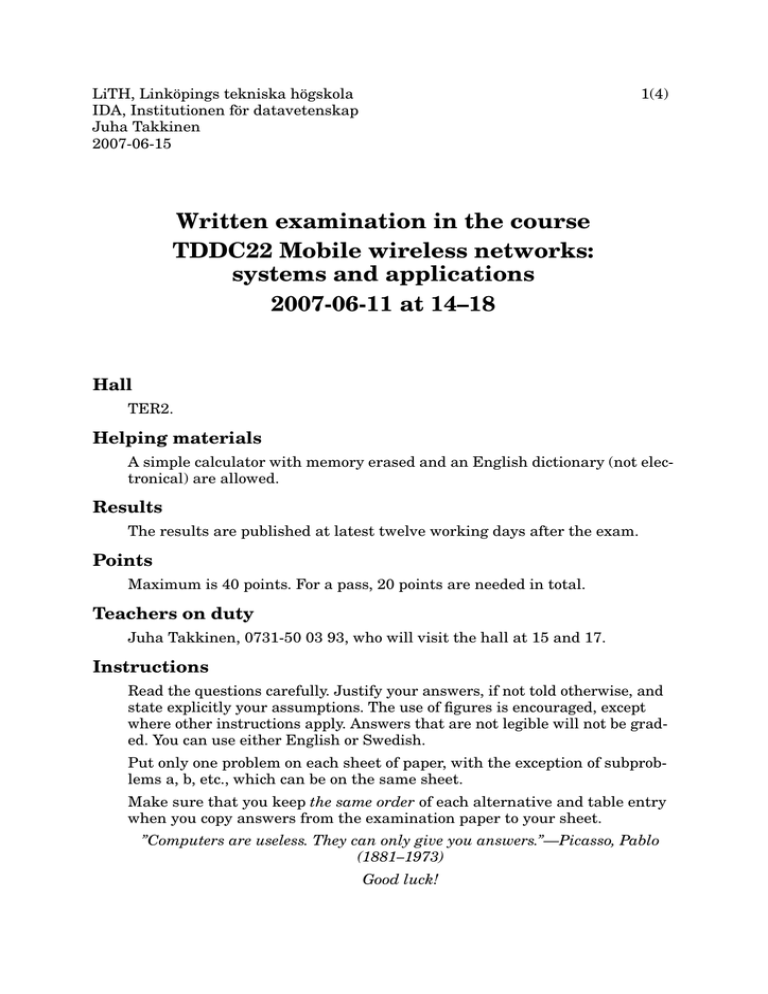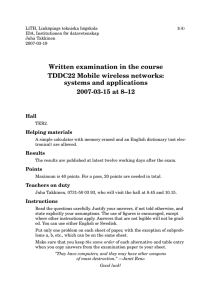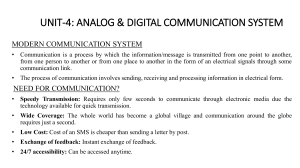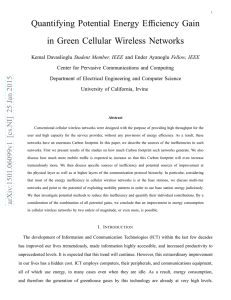Written examination in the course TDDC22 Mobile wireless networks: systems and applications
advertisement

LiTH, Linköpings tekniska högskola IDA, Institutionen för datavetenskap Juha Takkinen 2007-06-15 1(4) Written examination in the course TDDC22 Mobile wireless networks: systems and applications 2007-06-11 at 14–18 Hall TER2. Helping materials A simple calculator with memory erased and an English dictionary (not electronical) are allowed. Results The results are published at latest twelve working days after the exam. Points Maximum is 40 points. For a pass, 20 points are needed in total. Teachers on duty Juha Takkinen, 0731-50 03 93, who will visit the hall at 15 and 17. Instructions Read the questions carefully. Justify your answers, if not told otherwise, and state explicitly your assumptions. The use of figures is encouraged, except where other instructions apply. Answers that are not legible will not be graded. You can use either English or Swedish. Put only one problem on each sheet of paper, with the exception of subproblems a, b, etc., which can be on the same sheet. Make sure that you keep the same order of each alternative and table entry when you copy answers from the examination paper to your sheet. ”Computers are useless. They can only give you answers.”—Picasso, Pablo (1881–1973) Good luck! 2(4) Wireless networks 1. The following are true or false about cellular wireless networks (check True or False, or none of the two. Do not motivate your answer. Copy the answer to your answer sheet in the same order.): (3 p.) True False a. ❏ ❏ The GSM architecture includes a database called “Visitor location register” (VLR). b. ❏ ❏ An example of a handoff in a cellular wireless network is when the mobile unit becomes responsible for the call instead of the base station. c. ❏ ❏ A cell is typically shown in the shape of a hexagon. d. ❏ ❏ Frequency reuse is a method of sharing the same frequencies among different cells. e. ❏ ❏ The first-generation cellular systems did not use encryption to prevent eavesdropping. f. ❏ ❏ TDMA and CDMA are two examples of techniques for multiplexing used in cellular systems. (0.5 points for a correct answer; – 0.5 points for wrong; 0 points for no answer; minimum 0 points on the whole questions or a maximum 3 points.) 2. Define the following concepts: (3 p.) a. WLAN b. exposed terminal. c. Bluetooth profile. 3. 4. Name and describe two general problems that satellite signals have when travelling from a satellite to a receiver. (2 p.) What is the purpose of the inter-frame spacing defined in the IEEE 802.11b standard? Exemplify. (2 p.) 5. Explain what the standard IEEE 802.16 is about by comparing it to the IEEE 802.11b standard and giving some typical characteristics. (2 p.) 6. List and compare two types of satellites with regard to factors such as propagation delay, number of satellites for global coverage, and typical services provided. (2 p.) 3(4) Telecommunication 7. The following are true or false about telecommunication (see question 1 above for instructions): (3 p.) True False 8. a. ❏ ❏ Frequency spread spectrum is used reduce the bandwith of a signal. b. ❏ ❏ The entropy a data source is a limit on how many errors that can be corrected. c. ❏ ❏ The channel capacity can be calculated from the probability distribution of the source. d. ❏ ❏ Code division multiple access is used to let several users share a common channe. e. ❏ ❏ It is impossible for the receiver to separate between two users sending on the same channel at the same time in the same frequency band. f. ❏ ❏ A Hamming code with parameters (n, k) compress data with rate k/n. Explain the following concepts with at most two sentences each: (3 p.) a. Phase-shift keying. b. Multiple access channel c. Signal-to-noise ratio 9. For each of the statement below, explain if it is true or false, and also motivate why. a. Statistical redundancy in image data can with good result be used instead of parity check information to correct channel errors. (2 p.) b. The rate of an error-correcting code has to be lower than the channel capacity to make it possible to find an error-correcting code with low error probability. (2 p.) 10. Draw a block diagram for a digital telecommunication system that transmits analog signals to a distant location over a noisy analog channel with limited capacity. Also give three advantages of a digital system over an analog system. (3 p.) 4(4) GIS 11. Describe the main characteristics of GIS, which are unique for this kind of systems. (2 p.) 12. Describe the different data structures used in GIS. Give examples of different types of data using the different structures. (3 p.) 13. Make a graphic representation of a simple vector coordinate system. Draw points, lines and polygons and illustrate how their coordinates can be obtained. (2 p.) 14. What problems could you possibly face during data collection? Give examples of different data sources. Name some characteristics with respect to data collection and selection of data sources. (3 p.) 15. Describe three different mobile GIS applications. Discuss their pros and cons from the perspective of your project in this course. (3 p.)







